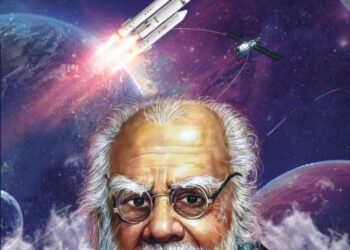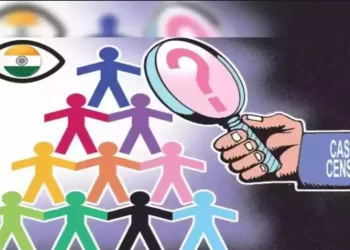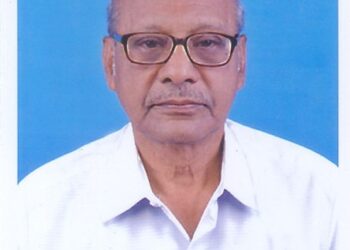The Disruptor: How Vishwanath Pratap Singh Shook India
by Debashish Mukerji,
Harper Collins Publishers
India, 2021;
pp 584, Rs. 699.
Political biographies are essential reading to understand the circumstances in relation to the decisions taken by a leader. It becomes more important if the decisions of the leader affect the entire politics of the nation. Vishwanath Pratap Singh has been one of the most vilified political leaders of India since August 7th, 1990 after his government accepted the recommendations of the Mandal Commission Report related to job reservations in Union government services and decided to implement it. India never witnessed that much of polarisation in its social and political life post-independence as during this short period when Singh was the Prime Minister of the country. Though his government was short tenured, Singh is considered to be one of the most iconic and impactful leaders in Indian political history whose decisions altered the landscape of India’s polity. Opinion makers not only vociferously critiqued his decisions but most of them also ignored his tenure as Union Finance Minister or the struggle that he carried against the Rajiv Gandhi government after resigning from the Ministry and prior to that as Chief Minister of Uttar Pradesh (UP). A complete biography of a person like Singh essentially gives a glimpse of the political history, events, and actions surrounding him.
Debashish Mukerji’s The Disruptor: How Vishwanath Pratap Singh Shook India is an essential reading for all those who are interested to know the politics and decision-making in the turbulent period of not merely his 11 months tenure but also his tenure as chief minister, and most importantly, his stint in the ministry of finance. The book also covers his life after demitting office when he played an important role in bringing the opposition together and strengthened civil society movements on the right to information and against land grab, as he launched a movement against the Dadari Power Plant in UP, owned by Reliance and then supported the issues related to land acquisition in Nandigram. Unfortunately, these incidents have not been reported in length in the book, even when the author has definitely worked well to highlight the economic policies of Singh when he was the finance minister.
Early Life and Political Career
Singh’s actions had a history, and without knowing that, it would be difficult to assess him. His earlier life was interesting and squeezed between the culture of his adoptive father Raja Ram Gopal Singh of Manda and his biological father Raja Bhagwati Singh of Daiya in the Allahabad region. He had often reflected upon his feudal upbringing, as quoted by the author: “If anyone living on the estate had a problem and sought his help, my father felt, it was his duty to provide it.”
His life insecurities perhaps made him a philosopher-politician, as “being born into a feudal family had brought him only loneliness and embarrassment” as his political opponents always charged him when he first contested against the veteran socialist leader Janeshwar Mishra. Influenced by Vinoba Bhave’s Bhoodan movement, Singh not only participated in the various activities of the “Sarvodaya” movement such as “shramdan” but also donated about 150-200 acres of “well-irrigated land” at the Pasna village. Even Bhave “sought to dissuade VP [Singh] from giving up all the land,” which deeply upset his biological father Bhagwati Singh who was careful that 900 acres land at the Daiya should not go the same way. But ultimately, Singh transferred the land to the Daiya Trust, as he did not want anything from his natural family after adoption. Such minute details provided in the book actually assume considerable importance in understanding the perception and ideological pursuits of Singh.
He was highly influenced by Jawaharlal Nehru and campaigned for him despite the “hostility” of local leaders. Later, he was closely associated with Lal Bahadur Shastri and allowed Lalita Shastri to start her “Lal Bahadur Shastri Sewa Niketan” from his fort in Manda. He entered the state assembly in 1967 by winning the Saraon constituency in a by-election. As a member of the legislative assembly, his first success was the acceptance of the demand of the protesting farmers of his region by the state chief minister Chandra Bhanu Gupta, who had opposed his candidature from the party. Singh kept himself acquainted with the issues of the common people as the author beautifully narrates in this book:
VP often travelled from village to village, recording villagers’ problems, driving a second-hand jeep whose gearshift he claimed only he could operate. Anyone who borrowed it returned almost at once. In that pre-laptop/smartphone era, he used a stash of index cards instead, which he could keep updating. Each card was devoted to a particular department, on which names of villages and their specific problems related to that department were recorded. “That’s how I always had data at my fingertips during meetings with either the Allahabad district administration or authorities in Lucknow.
During the same period, Dalits in some of the villages of his constituency decided against engaging in their “traditional work” like disposing of carcasses and women working as midwives to help other caste women during their deliveries. The refusal of the Dalits was not taken lightly by the upper castes who threatened economic boycott against them. Singh was able to handle the issue, telling the upper castes, “You can’t force any one to do what he does not want to do.”
Singh won his first Lok Sabha election in 1971 from the Phulpur constituency, defeating Mishra who was initially very contemptuous towards him. He was inducted in the union cabinet by Prime Minister Indira Gandhi as the deputy minister of commerce on October 10, 1974 where his boss was Debi Prasad Chattopadhyaya, a great philosopher-politician from West Bengal. He remained with Gandhi during the infamous emergency period, but then he was a very junior minister and not much could have been expected from him at that point of time. He lost to Mishra in the general elections of 1977 with a heavy margin. Gandhi and the Congress had lost the elections heavily.
Singh has often been accused of being “ambitious” and an “opportunist” but a careful study of the book under review provides fascinating details of the life of a man who was not merely a politician, but an extremely sensitive soul, an artist as well as a poet. He refused the prime ministership when it came to his door during the formation of the United Progressive Alliance which compelled opposition leaders to elect the Karnataka Chief Minister Deve Gowda for the post. The book contains an interesting episode of how Singh secretly left his house and continued roaming around the ring road in his car to avoid meeting political leaders who were determined to make him the leader again.
People ignore Singh’s enormous contributions in creating a debate in the polity on various issues and taking them to their logical conclusion. For him, the Mandal Commission was a commitment to be fulfilled as per the manifesto of the Janata Dal Party. There are many other issues which seems not to have been found their way in the book, like giving Bharat Ratna to B R Ambedkar and Nelson Mandela, extending reservation to Buddhist converts from Scheduled Castes, which was an extremely emotional issue for Ambedkarites, as well as his stand on the Ayodhya issue. After resignation as the Prime Minister, Singh travelled across the country to get the Mandal Commission report practically implemented by the government, and courts finally upheld his decision to do so. In fact, Singh was the first one to propose K R Narayanan as the President of India, which ultimately became a reality after all parties unanimously accepted that proposal.
Though capturing the life of Singh is a difficult task, the author has been able to chronicle those moments which were out of sight. Singh was an active participant in the campaign for the Right to Information as well as for the National Rural Employment Guarantee Scheme.
Assessing Singh’s Impact
Singh’s life story as well as his political interventions need more understanding in the academia. At a time when probity in public life is fast disappearing and political leaders are more known for their compromises, Singh remains an oasis whose main strength was his ability to mix up with the people and never let the “security” and “protocol” get in his way. His ideological politics did not take him anywhere as neither OBCs accepted him as their leader nor did the Thakurs, who felt betrayed by his “Mandal” sin. As the author says in his “Introduction: “For a person who impacted Indian politics as profoundly as did V P Singh, his posthumous neglect is a disgrace, as there is not even a stamp issued in his honor let alone a street or a state-owned institution named after him, even in his native Allahabad.” There is no doubt that the author has tried his best to “redress the imbalance” about Singh, and to some extent, he has succeeded as well. But he is also being blamed for some shortcomings. The book is based upon certain conversations with some of his close associates as well as his own interviews from the oral history section at the Nehru Memorial Museum and Library. One section on Singh should have been the role of the media, both in 1987–89, when he left Rajiv Gandhi’s cabinet and after the Mandal Commission report. An interview and assessment of the politics of Arun Shourie would have been interesting as he was closely associated with Singh, but drifted away from him after the Mandal report.
The second important aspect that the book seems to miss is about the relationship that Singh had with the Bahujan Samaj Party (BSP) founder Kanshi Ram, who contested against Singh in Allahabad by-election and was a critic of his politics. But, by the end of December 1993, both he and Singh had met several times and were about to forge an alliance as reported in the February 15, 1994 issue of India Today. Both Kanshi Ram and Mulayam Singh targeted VP Singh more than any other party when Samajwadi Party–BSP forged an alliance in UP in the 1993 state elections in the aftermath of the Babri Masjid demolition. What would have happened if VP Singh and Kanshi Ram had allied and fought jointly? Maybe, scholars can explore these issues further, whether VP Singh really had an “ideology” or he was simply a “do-gooder.” This book has provided enough material in this regard, right from his childhood till the fag end of his life. The author deserves kudos for his superbly chronicled work on Singh, and it is hoped that the work will inspire scholars to explore more about his ideological perceptions and politics.









